Are SEO Content Gap Analyses Overrated?
Topic: Content Marketing
Published:
Written by: Bernard Huang
Just as businesses look for untapped opportunities to best their competitors, content marketers need to pinpoint content gaps to stay ahead of the curve.
These gaps in consumer needs and intent are a treasure trove waiting to be found, but how do you spot them?
Through a content gap analysis.
Depending on your content marketing strategy, this may involve an in-depth exploration of every corner of your website, some hard-hitting competitor research, or, ideally, both.
Once you’ve identified a specific content niche, you can add missing information to your existing content or create entirely new pieces.
What is a content gap analysis?
A content gap analysis involves looking for missing information in your website’s content or on competitor websites. Content creators, content managers, and search engine optimization (SEO) experts use this process to help them meet user expectations.
A content gap could relate to:
Missing content: If content is missing, it hasn’t been covered at all. This may seem like the most obvious gap, but you might not spot it at first glance.
Incomplete content: If your content is incomplete, readers will get some of the information they want, but they’ll still need to continue their customer journey elsewhere. You may have missed a subtopic that readers originally visited your webpage to find out about.
Outdated content: Outdated content suggests to users that you don’t update your website. To stay relevant, set aside time each month to update old content.
For example, if you write how-to guides on software installation but don’t give instructions for installing the latest version, users may look elsewhere for this information. But by making a few changes, you can give readers what they need and boost engagement.
To conduct a content gap analysis, you’ll need to consider all three types of content holes and how they involve you, your competitors, and — most importantly — your readers.
As part of your search for elusive content gaps, research the keywords that your competitors are ranking for.
"However, you can’t just add high-ranking keywords to your blog and hope for the best. All that’ll do is paper over your content cracks. What’s more, Google’s algorithm is wise to these methods."
Instead, you need to combine data-driven marketing and user-centric approaches to ensure your content creation efforts result in relevant, high-quality content that users want.
How to do a content gap analysis
Examine user intent.
Compile a content inventory.
Analyze your internal content.
Check out the competition.
1. Examine user intent
To find content gaps, you need to have a strong focus on user intent (also called search intent). In a 2022 Clearscope webinar, JR Oakes of LOCOMOTIVE got to the nub of user intent:
“What is the thing people are looking for? That’s what we’re going after. It’s not the millions of keywords, but what do people want. … What’s their intention or purpose?”
For your content gap analysis, think about the four main types of user intent and measure your content against each of them.
Your target audience could have informational, navigational, commercial, or transactional intent.

Types of user intent to consider during a content gap analysis.
But there’s a caveat:
Just because you’ve identified unfulfilled or inadequately served user intent doesn’t mean you should devote effort to filling it.
"If the content you produce is unlikely to lead to increased conversions, then your efforts may be better spent elsewhere."
The key is to find relevant content gaps that you can rank for and increase user engagement. This may involve some trial and error.
2. Compile a content inventory
Before you dig into the quality of your website’s content, you’ll need to find out just how much you have. To do this, create a content inventory.
Much like a grocery store stocktake, this involves going through all the parts of your website to evaluate your content assets.
If you’re conducting a content gap analysis — or even doing a full content audit — this is one step you shouldn’t skip.
Think of it this way:
Before you analyze your personal finances, your first step should be finding out how much money you have. The same applies to a content gap analysis — you need an overview of the content you have before you can explore new growth avenues.
After all, if you’re constantly updating your website with new blog posts, pillar pages, and product pages, you might forget about old material that could benefit from a content refresh.
When creating your content inventory, you should pay attention to certain content characteristics that could help you identify gaps, such as titles, meta descriptions, and keywords.
If manually compiling all your live URLs seems like a chore, you can use a website crawler like Screaming Frog's SEO Spider.
After downloading the tool (the free version allows you to crawl up to 500 URLs), enter your domain into the search bar. We’ve used Bodega’s website here to see how its content compares with competitors.
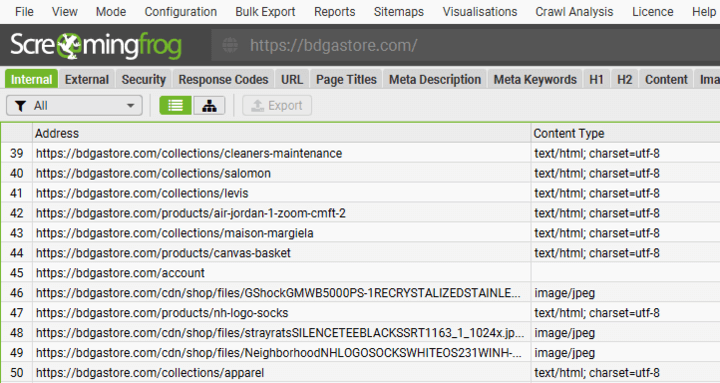
Screenshot of Screaming Frog in action.
You can now export your inventory to a spreadsheet.
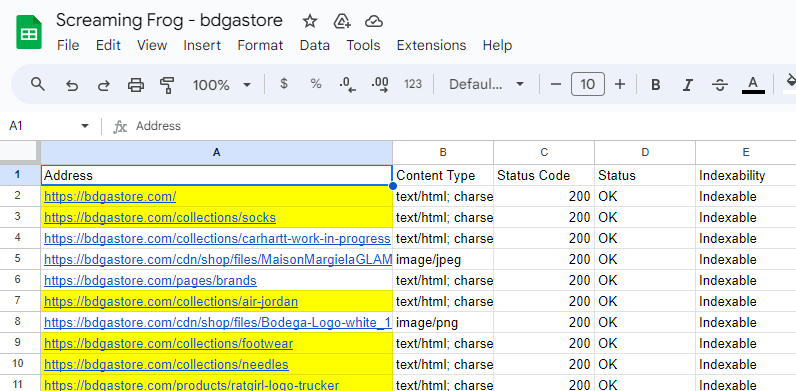
Content inventory exported to Google Sheets.
Add these URLs to Clearscope’s Content Inventory tool to get an overview of every piece of content your website holds.
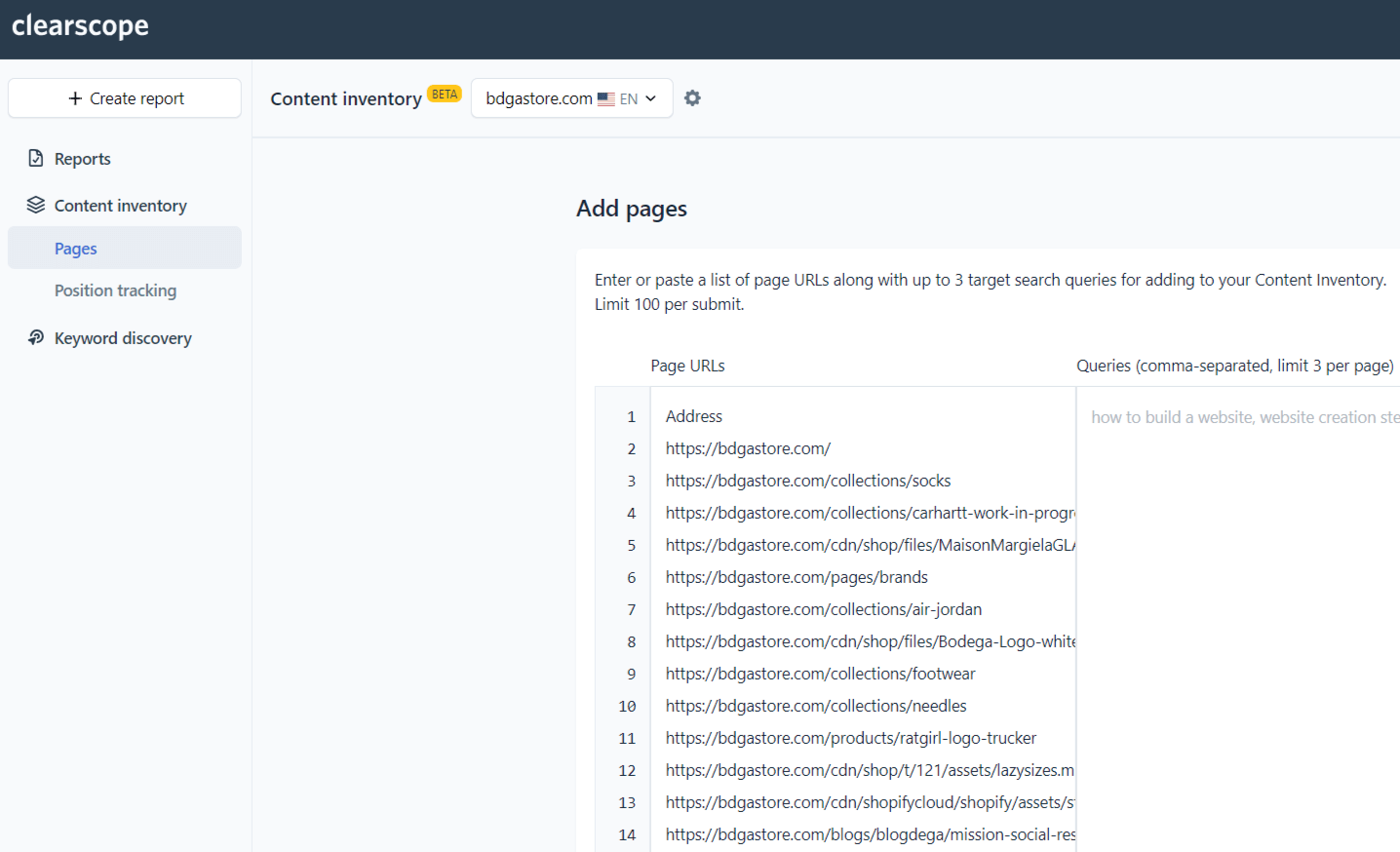
Screenshot of Clearscope’s Content Inventory tool.
3. Analyze your internal content
You’ll need to do a deep dive into your content at the quantitative and qualitative levels. If you’re using Clearscope’s Content Inventory tool, you can find out the content grade of any page on your website.
Your content grade becomes higher as you add semantically related keywords in your article. As such, a low content grade can help you easily spot content gaps based on missing keywords.
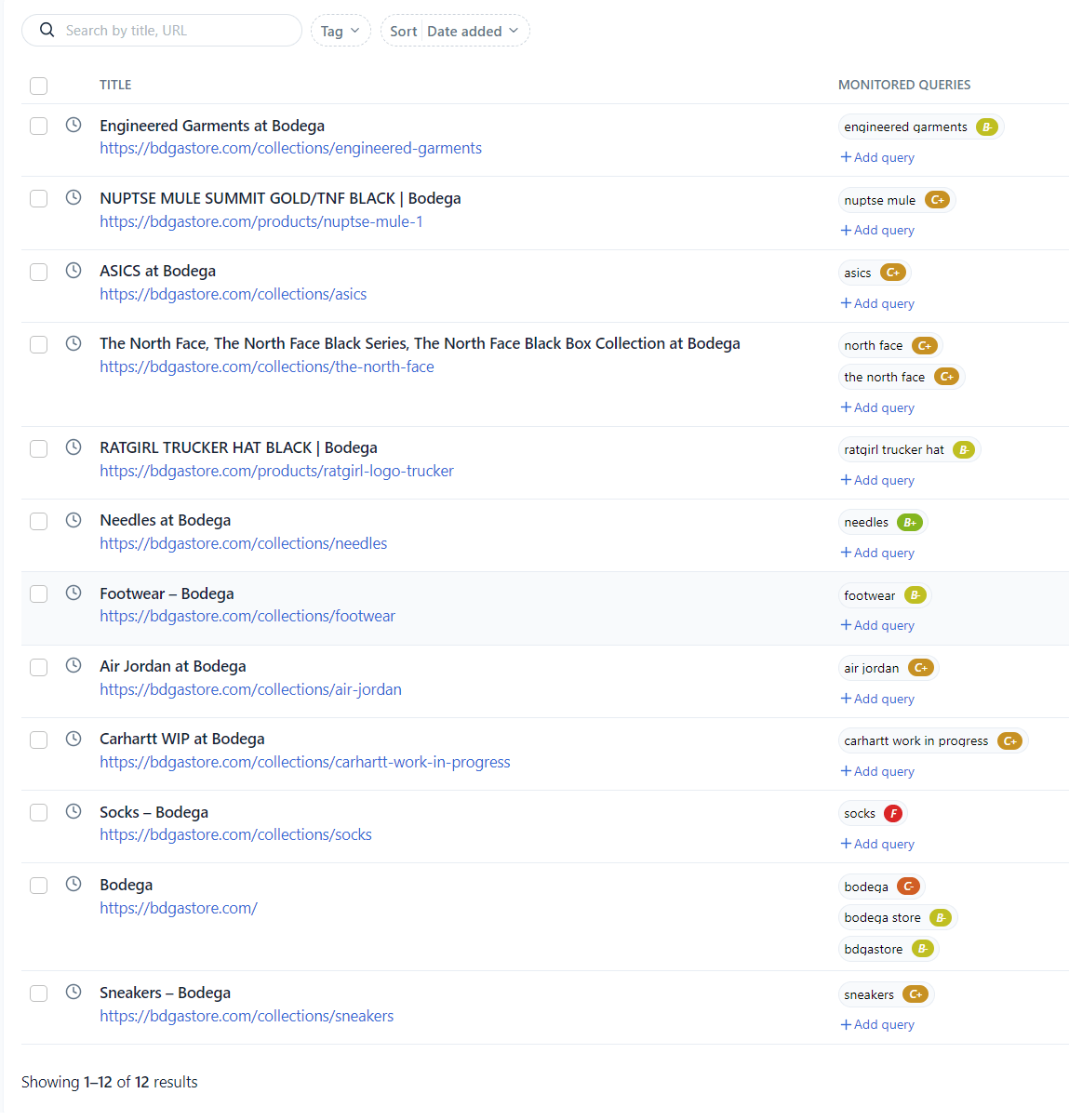
Clearscope grades for various pages on Bodega’s website.
Depending on how your website is structured, you may need to look at different types of content. For example, you could examine everything from landing pages to case studies.
We recommend using various performance metrics to give you some clues about content gaps. For example, you can analyze your organic traffic, conversion rate, bounce rate, and click-through rate (CTR).
If you have a high bounce rate, it’s possible that user intent hasn’t been fulfilled. So, go through any webpages with a high bounce rate and check if the content is relevant.
For example, if a blog post’s title is “Best High-End Restaurants in San Francisco,” make sure visitors get what they expect, not a description of a single fast food chain 50 miles away.
Google Search Console and Google Analytics can help you out, but be sure to combine measurements for a complete picture.
For example, high organic traffic is good to have, but if you also have a low conversion rate, your content could be underperforming.
Remember that not every piece of content has to cover all stages of the buyer’s journey. But at the very least, ensure that every potential customer journey is covered in some of your content.
You can use a customer journey map for reference to ensure you’ve covered each stage adequately. Depending on your business, these stages could be as follows:
Awareness → Consideration → Decision → Retention → Loyalty
Your customer base can also help you spot gaps. For example, customers may have contacted your marketing team about a product or expressed their preferences and questions on community forums or surveys.
4. Check out the competition
Competitor analysis has long been a vital step in market research, so there’s no shame in having a peek at your competition’s content. You can bet your competitors are checking their rearview mirror, too.
As you start your competitive content analysis, keep these questions in mind:
What topics and subtopics are your competitors talking about?
How can you talk about these subjects differently?
What are competitors not talking about?
Don’t know who your competitors are?
Start by typing any keywords you want to rank for into Google. Have a look at the search engine results pages (SERPs) and open the first few URLs that appear.
These are your keyword competitors. Even if the companies behind these URLs aren’t direct business competitors, you’ll still want to try to outperform them.
That’s because your SERP ranking is important for bringing organic traffic to your website. According to SearchPageSage, the number one search results in Google get a whopping 39.8% of all clicks.
If you don’t have specific keywords in mind yet, search for companies that offer the same type of products or services as you.
Once you’ve found out who your competitors are, look at their content to see what they’re doing right.
You can use various SEO tools to see what other keywords your competitors rank for.
For example, if you run a Clearscope report on your target keywords, you’ll get a list of new keyword opportunities that your competitors have included in their content.
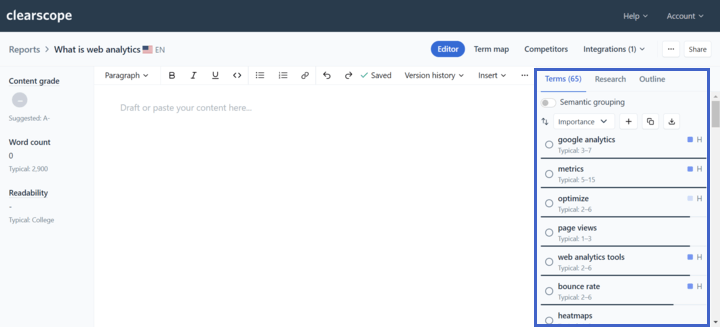
A Clearscope report showing keywords competitors are using related to “what is web analytics.”
If you’re writing an article on web analytics, you’ll see that “page views” and “heatmaps” are common keywords.
Again, these related keywords can only do so much — it’s up to you to build coherent and relevant new content around them.
Instead of simply mentioning the terms “page views” and “heatmaps,” define them and explain what they mean in a web analytics context.
You should expand on areas that you don’t think your competitors covered adequately. Also, if you’re going to cover the same topic as your competitors, try to use a fresh angle rather than simply rewording what they’ve written. This could involve adding insightful commentary or up-to-date information.
Next, try to figure out your competitors’ missed content opportunities. For example, if you’re a food blogger, competitors may have written about quick and healthy lunch recipes but neglected to include options for people with restrictive diets.
If you plug this gap, you could increase your website traffic and find new growth opportunities.
Content gap analysis checklist
There’s no one-size-fits-all approach to doing a content gap analysis, but by keeping the key goals in mind, you have a better chance of spotting those golden gaps.
Here are some points to consider at every step:

Content gap analysis checklist.
Why content gap analyses are important
If you use web content to drive business growth, a content gap analysis should be a critical part of your content strategy.
And since SEO tools like Clearscope are readily available, even teams with small digital marketing budgets can do their own content gap analyses — and reap the benefits.
Give your target audience what they want
Content gaps represent unfulfilled search intent, and if you identify them, you stand a better chance of reaching customers in every part of the sales funnel.
For example, if a user is looking for information on the best sneakers on the market, they’ll probably appreciate a shoe review or comparison webpage.
But if your brand only offers a shoe checkout page, they won’t have the information they need to decide on a purchase.
So, they’ll land on another brand that offers a satisfying comparison of various sneakers, and you’ll have missed an opportunity to keep users engaged.
According to a 2022 HubSpot report, 44% of consumers used internet searches for self-education on products. If you give consumers all the information they need about a product, you could gain their trust and boost sales.
Keep up with competitors — or surpass them
By examining the content of your top competitors and comparing it against user intent, you should be able to see what your website is missing and where you can beat your competitors.
Competitor keywords can be a good jumping-off point. Look for keyword gaps you can use as inspiration for topics to fill in the missing pieces of your content puzzle and become more compelling than your rival brands.
Depending on your website’s structure, these missing content pieces could fit well in one of your existing topic clusters.
Identify content ideas
Think you’ve exhausted all the content in your area of expertise? You might just be in need of some inspiration.
A content gap analysis can help you come up with new blog ideas or even guide a content refresh.
Content gap analyses aren’t for everyone
Not every content marketer will reap the full benefits from a content gap analysis.
For example, it may not be the optimal strategy for:
Niche businesses: If you’re one of the few content creators covering a certain topic (e.g., AI-generated pet portraits), competitor research may not have much value.
Industry experts: If you’re already an industry thought leader, your time may be better spent on other endeavors, such as conducting expert interviews and growing your personal brand.
Dynamic industries: If you cover topics that are changing rapidly, your analysis might become irrelevant or outdated. It might be more helpful to research new trends and maintain a consistent content publishing calendar.
Final thoughts: How to do a content gap analysis — a comprehensive guide
If your content strategy doesn’t include a content gap analysis, it’s time to start thinking about how you can integrate one into your workflow.
If you don’t, you could pass up opportunities for customer engagement, allowing your competitors to stay one step ahead.
Although a content gap analysis sounds like a painstaking process, you don’t have to go it alone. Clearscope can help you spot content gaps and apply some finishing touches to your content.
For a personal live demo and information on customized plan options, get in touch with our team today.
Competitive Content Analysis: Your Step-by-Step Guide
Competitive content analysis is when you research the top-ranking content to figure out what best practices to follow to rank higher on the SERPs.
Read moreHow to Create a Content Inventory & Perform a Content Audit
Our post explains how to perform a content inventory, audit your existing website content, and maintain an SEO-optimized site — in four simple steps.
Read moreHow To Do a Content Audit in 5 Easy Steps
Our post explains how to do a content audit in 5 clear steps — we also answer FAQs and talk about the best content audit software to support your processes.
Read more